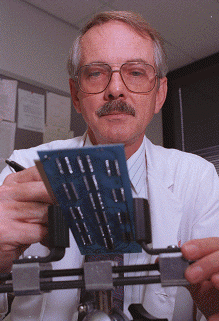EDWARD L. WILLS, Research Associate Professor
(205) 934-5347,
wills@uab.phy.edu
Instrumentation for Space Exploration
 In collaboration with Physics colleague David Agresti and NASA
Johnson Space Center, our work involves hardware development for a
backscatter Má”ássbauer spectrometer/x-ray fluorescence analyzer
(BaMS/XRF). This extraterrestrial prospector will analyze the
surface of such distant bodies as mars and the moon. Since
spaceflight requires the minimization of volume, mass, and energy
consumption, our efforts are aimed at modifying the 10 kg
laboratory spectrometer to meet these restrictive specifications.
So far we have managed to reduce the spectrometer to the size of a
soft-drink can and have reduced power requirements to less than two
watts. Our future work in this area will focus on producing a
flight ready instrument from the prototype.
In addition to my research, my responsibilities in the graduate
program include the supervision of graduate teaching assistants
and recitation instructors. Many beginning graduate students will
serve as laboratory instructors for introductory courses and/or
lead problem solving sessions for students enrolled in the calculus
and non-calculus based physics courses.
In collaboration with Physics colleague David Agresti and NASA
Johnson Space Center, our work involves hardware development for a
backscatter Má”ássbauer spectrometer/x-ray fluorescence analyzer
(BaMS/XRF). This extraterrestrial prospector will analyze the
surface of such distant bodies as mars and the moon. Since
spaceflight requires the minimization of volume, mass, and energy
consumption, our efforts are aimed at modifying the 10 kg
laboratory spectrometer to meet these restrictive specifications.
So far we have managed to reduce the spectrometer to the size of a
soft-drink can and have reduced power requirements to less than two
watts. Our future work in this area will focus on producing a
flight ready instrument from the prototype.
In addition to my research, my responsibilities in the graduate
program include the supervision of graduate teaching assistants
and recitation instructors. Many beginning graduate students will
serve as laboratory instructors for introductory courses and/or
lead problem solving sessions for students enrolled in the calculus
and non-calculus based physics courses.
Instrumentation:
- Mossbauer spectrometers
- Fast Fourier transform spectral analyzer
- Pulse amplifiers, scalers, multi/single channel analyzers
Collaboration:
Recent Publications:
- Backscatter Mssbauer spectrometer (BaMS) for
extraterrestrial applications, D.G. Agresti, T.D. Shelfer, M.M.
Pimperl, E.L. Wills, M.H. Shen, and R.V. Morris. In B.A. Wilson
(ed) Proceedings of the Workshop on Microtechnologies and
Applications to Space Systems. Jet Propulsion Laboratory
Publication 93-8, 95 (1993).
- Extraterrestrial Mssbauer spectrometry, D.G. Agresti,
R.V. Morris, E.L. Wills, T.D. Shelfer, M.M. Pimperl, M.-H. Shen,
B.C. Clark, and B.D. Ramsey, Hyperfine Interactions, 72, 285
(1992).
 In collaboration with Physics colleague David Agresti and NASA
Johnson Space Center, our work involves hardware development for a
backscatter Má”ássbauer spectrometer/x-ray fluorescence analyzer
(BaMS/XRF). This extraterrestrial prospector will analyze the
surface of such distant bodies as mars and the moon. Since
spaceflight requires the minimization of volume, mass, and energy
consumption, our efforts are aimed at modifying the 10 kg
laboratory spectrometer to meet these restrictive specifications.
So far we have managed to reduce the spectrometer to the size of a
soft-drink can and have reduced power requirements to less than two
watts. Our future work in this area will focus on producing a
flight ready instrument from the prototype.
In addition to my research, my responsibilities in the graduate
program include the supervision of graduate teaching assistants
and recitation instructors. Many beginning graduate students will
serve as laboratory instructors for introductory courses and/or
lead problem solving sessions for students enrolled in the calculus
and non-calculus based physics courses.
In collaboration with Physics colleague David Agresti and NASA
Johnson Space Center, our work involves hardware development for a
backscatter Má”ássbauer spectrometer/x-ray fluorescence analyzer
(BaMS/XRF). This extraterrestrial prospector will analyze the
surface of such distant bodies as mars and the moon. Since
spaceflight requires the minimization of volume, mass, and energy
consumption, our efforts are aimed at modifying the 10 kg
laboratory spectrometer to meet these restrictive specifications.
So far we have managed to reduce the spectrometer to the size of a
soft-drink can and have reduced power requirements to less than two
watts. Our future work in this area will focus on producing a
flight ready instrument from the prototype.
In addition to my research, my responsibilities in the graduate
program include the supervision of graduate teaching assistants
and recitation instructors. Many beginning graduate students will
serve as laboratory instructors for introductory courses and/or
lead problem solving sessions for students enrolled in the calculus
and non-calculus based physics courses.